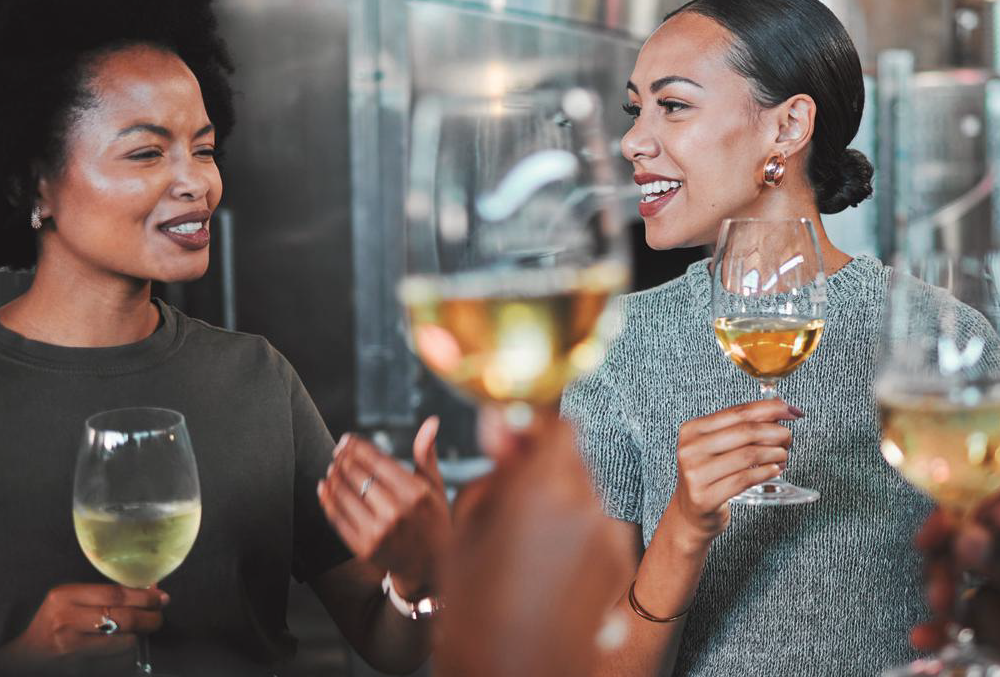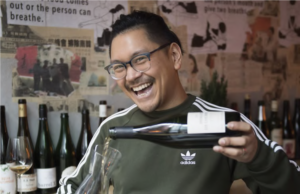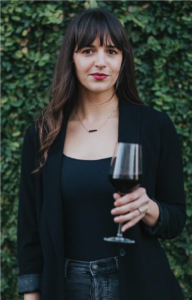
![To become more inclusive and accessible, a growing industry movement is questioning traditional, often Eurocentric wines descriptors in both the classroom and on the floor.[Photo by Adobe Stock.] To become more inclusive and accessible, a growing industry movement is questioning traditional, often Eurocentric wines descriptors in both the classroom and on the floor.[Photo by Adobe Stock.]](https://www.thebeveragejournal.com/assets/inclu-wnie-0523-1-e1682518373567.png)
To become more inclusive and accessible, a growing industry movement is questioning traditional, often Eurocentric wines descriptors in both the classroom and on the floor.[Photo by Adobe Stock.]
If you’ve ever reviewed tasting notes for Sauvignon Blanc, you’ve undoubtedly encountered the gooseberry. Common across Europe, this tart and tangy fruit is regularly referenced in wine reviews and descriptors despite the fact that few people in the United States have ever met a gooseberry in real life.
Though the use of such Eurocentric descriptors has been common practice in the U.S. for decades, the tide is turning as the nation’s population becomes more racially and ethnically diverse. The U.S. Census Bureau projects that by 2028, nearly 15 percent of the country’s residents—a higher percentage than any time since 1850—will have been born in another country.
As the non- Hispanic white population shrinks over the coming decades, the federal agency expects the population of mixed-race people to become the nation’s fastest-growing racial or ethnic group, followed by Asians and Hispanics. By 2045, the report forecasts, whites will no longer make up the majority of the U.S. population.
Now, as the U.S. wine industry recognizes the need to engage younger, increasingly multicultural consumers, forward-thinking industry professionals are calling for a more inclusive wine lexicon that reflects the country’s current and future demographics.
BREAKING THE EUROCENTRIC MOLD
Meg Maker, the New Hampshire-based publisher of Terroir Review and an independent researcher, has spent years studying and pondering the language of wine. But it wasn’t until 2020, after reading an essay in Punch magazine by wine professional Miguel de Leon titled “It’s Time to Decolonize Wine,” that she began to question the traditional model.
Revamping traditional wine language is hardly a new idea, she says, but the concept has lately taken on new urgency. “Certainly, there’s the economic existential crisis that the [U.S.] wine industry is facing,” says Maker. “It invites those who may have felt that this was a comfortable time to sit back in our armchairs to sit forward and really look at everything we’re doing with an eye toward how we can do better, so that we’re profitable. “At the same time,” adds Maker, “I think there is an appetite toward social justice that many in the industry are experiencing right now.” Part of that movement, she says, is an effort to expand the lexicon of wine.

Miguel de Leon, the wine director at Pinch Chinese
This has long been the mission of de Leon, the wine director at Pinch Chinese in New York City and a resource council member with the Hue Society, an organization that works to increase access and representation for BIPOC professionals in the wine industry.
“In a climate where it seems like wine got caught up in the whole radical inclusivity discussion two or three years ago, there still hasn’t been any major push for vocabulary to shift toward being even more American,” says de Leon. “The current structures and systems of wine vocabulary, how we teach a new generation of people to come into the legitimized profession of it, are very old—almost from the Pax Britannica era of the British Empire. I’m trying to break us out of that mold.”
De Leon points out that in the London- based Wine & Spirit Education Trust (WSET) diploma tasting grid, there are nuances elucidated by qualifiers when it comes to apples, and most instructors will differentiate between green and red apple varieties. “But when you start talking about fruits that come from anywhere in the tropics, it’s just ‘tropical fruit’ or ‘mango,’” he says. “I grew up with four kinds of mangoes [in Manila] and each one is different. That’s what I mean when I say it’s time to decolonize. We need to get out of that practice, because the centricity of it solely falls on the European palate.”
RETHINKING PROFESSIONAL EDUCATION PROGRAMS
Moving toward inclusivity will require a reexamination of wine education programs, says Maker, so that people coming up in the industry can move beyond the current terminology.
“I think there’s a huge onus on educators to be broad-minded, to be encouraging of diverse perspectives within the student body, to really interrogate their existing lexicons actively, and to put everything on the table,” she says. “I think it’s the right time for that—for wine educational systems to go from feeling that there’s a universality of flavor analogy to honoring and welcoming individual perspective.”
In 2020, WSET embarked on a plan to move away from its Eurocentric tasting vocabulary. However, the program appears to be moving slowly. “We don’t currently have an update on this project,” says marketing director Carolyn d’Aguilar, “but it is still something that is very much on our radar.” de Leon, who holds a certificate from WSET, notes similar issues with professional wine education programs—even at the university level. “I feel like everybody has just fallen in love with the [UC Davis] aroma wheel as the only thing that we should be consulting, but the wheel can get bigger,” he says. “Just because we’re putting in more pie wedges, it doesn’t mean that anything else gets lost in terms of its value.”

Rania Zayyat, the wine director and managing partner at Bufalina restaurant in Austin, Texas, and the founder of Lift Collective
The use of technical jargon is another concern, he says, particularly with the chemical realm of the aroma wheel. “It’s hydrogen and hydrogen sulfide and sulfur dioxide,” he says. “Well, what does that smell like? You’ll go to a tasting and people are talking about terpenes and pyrazines. That’s great, but you’ve just alienated the person who is brand new to this space. In itself, the jargon becomes gatekeeping.”
Rania Zayyat, the wine director and managing partner at Bufalina restaurant in Austin, Texas, and the founder of Lift Collective, which advocates for equity and inclusion in the wine industry, studied with the Court of Master Sommeliers for six years before walking away from the program in 2017.
“I didn’t realize it at the time,” she says, “but it was very much like, ‘This is what this grape tastes like.’ So if you’re going to describe it in a blind tasting, you have to say these things for it to be correct.”
Alicia Towns Franken, the executive director at Wine Unify, a nonprofit that provides mentorship and educational opportunities for underrepresented minority groups, says real change will come only when educational programs involve diverse professionals in the revamping process.
“It really is about bringing in the stakeholders,” she says. “Don’t just prescribe things for people and expect that you’re going to hit all the points that they need to hear. They should be at this table. You can always tell when people are not in a room when certain decisions are made.”
TAKING A DIFFERENT APPROACH
Instead of sticking to the prescribed descriptors, Zayyat, Franken, and other wine professionals are carving their own paths. Zayyat encourages Bufalina staff to describe wine in ways that make sense to them. “I try not to give out tasting notes because they are purely subjective,” she says. “I think [talking about] structure makes more of a difference.” She’ll also focus on measurable elements such as tannin, acid, sugar levels, and alcohol.
With customers, she tells the story of texture and style. For example, she may describe a wine as round and soft on the palate, with fruit that’s tart and bright or ripe and round. Zayyat makes a point to avoid throwing out technical details without explanation.
“If I tell a table, ‘This wine is made with carbonic maceration,’” she says, “I also provide a little bit of context about what that actually means for the wine rather than just leaving them hanging.” Like Zayyat, Alice Achayo, the founder of The Wine Linguist, a new consultancy that aims to connect global cuisines with wine through trade and consumer education, also homes in on components such as tannin and acidity.

Alicia Towns Franken, the executive director at Wine Unify
“Those are things that we can use to talk about the structure of a wine that we can teach people to [recognize],” she says. “But the notes themselves should come entirely from your own nose.” However, describing wine texture can be similarly subjective, she adds. Recently, while tasting a Chardonnay and an Albariño with a friend who works as a chef, Achayo realized that the common practice of comparing wine body to skim versus whole milk doesn’t work for everyone.
“She described the Albariño as being like a vegetable broth, very clear and clean, whereas the Chardonnay was like a bone broth because it had this gelatinous weight,” says Achayo. “Rather than using milk, my friend used something that was clear to her in her own experience. It’s understanding people’s cultural background and the cuisines they grow up with, and finding commonality in language they understand.”
Franken also likes to connect non-Eurocentric foods with wine, as she did for a Wine Unify exercise called “Your Brioche is My Biscuit.” “It’s finding ways to break down what these terms really mean,” she says, “and how you can make the language more inclusive.” Engaging with younger consumers, she adds, is about tapping into experiences and casual occasions. When describing a Prosecco, for instance, Franken might say that it’s a great wine for hanging out with friends at the beach—instead of telling them what the wine is supposed to taste like.
Femi Oyediran, the co-owner of Graft Wine Shop in Charleston, South Carolina, compares himself to the go-to guy at the record store who turns people on to music he knows they’re going to love. In talking to consumers about wine, he tailors his language and story to suit his audience.
“Different strokes for different folks,” he says. “You can ask a few questions of people and find out very quickly who you need to be and how you need to pitch the sale.” If Oyediran is selling a $16 bottle of Sauvignon Blanc, he might tell the customer how thrilled he is that they’re buying this particular wine, because it’s his favorite for kicking back after work and streaming HBO.
“I might say something like, ‘I’m so happy you’re on this team! Can we be on this Sauvignon Blanc team together? Hashtag Sauv16, let’s go!’ And they’re laughing and they’re buying the bottle of wine and they feel great,” says Oyediran. “There’s no lecture about the wine itself, but if they wanted that, they could have it.”
When writing about wine in Graft’s newsletter, Oyediran strives to convey his enthusiasm for the selections and the pleasure that they bring. “One of my coworkers when I was at Charleston Grill would always say that when you’re describing food, it’s really important to use mouthwatering adjectives, so I try to use language that points to the wine just being delicious,” he says. “I always try to be clever and think about what I would want to hear versus the standard terms of wine writing and sales.”
When describing the Fief de Chaintre from Loire Valley, for instance, Oyediran writes, “It’s the Burgundy lover’s coastal getaway—taut, flavorful, chiseled, and tasty. Rips with seafood, too. What the hell are you waiting for? Jump in. The water’s lovely.”

Femi Oyediran, the co-owner of Graft Wine Shop in Charleston, South Carolina
Similarly, de Leon uses images or personality to cultivate empathy rather than spouting descriptors. “I can have you taste seven Grenaches, and you’re going to write the same tasting note for all of them,” he says. “But you can attach a feeling to how you were before and after you tasted the glass.” A taster might notice that the wine took them to a place that was too sour, De Leon says, or that felt lush and jammy. “I’d rather find the nuance in those kinds of liminal wine spaces than say for the ninth time that we’re going to taste raspberry.”
Maker, who points out that her approach to writing tasting notes for her website is a work in progress, stresses the importance of not forcing words into consumers’ mouths. “One actionable item, if you’re a winery, is to train your tasting room staff not to tell people what they’re tasting as it’s being poured,” she says. “They will often say, ‘Well, this rosé has really got beautiful strawberry fruit with a little bit of watermelon,’ and if [the consumer] doesn’t taste those things, then they must not get it.”
EXPANDING LANGUAGE THROUGH WORKFORCE DIVERSITY
Creating a more inclusive lexicon for wine involves not only understanding people from diverse cultures and ethnicities, but also hiring them in key, consumer- facing positions. “That’s huge because they bring in their own vocabularies and their own sets of relationships and their own people,” says de Leon. “They’re going to listen to music that I don’t, they’re going to look at art that I don’t, and they’re going to have their own experiences. And that enriches me whenever I’m around them.”
Communicating with consumers of different ethnicities and cultures isn’t about describing wine in some universal way, adds Franken, but meeting them where they are. “If we can learn all of these wine terms and all of these other things about wine, we can learn about different cultures and languages,” she says. “The simplest way to do it is to include these demographics in your workforce. If you are going to pretend to know the foods that I eat and what my culture looks like and you’ve never experienced it and you’re not a part of it, then how will you know? You’re just going to make a mistake and it’s not going to be great for you.”
Achayo, like Franken, is calling for wine professionals to do better. “If we’re going to say that we are experts, then we have to become polyglots of wine languages,” she says. “We can’t be recycling and regurgitating the same descriptors and same culture around wine. We have to challenge ourselves.”



